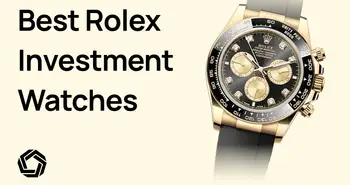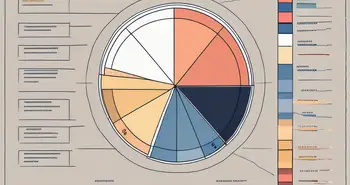How to Invest in Watches

In the not-so-distant past, alternative investments resided in the exclusive realm of the privileged few—the affluent elite with their classic cars, rare watches, or the devoted collectors of comic books, oftentimes considered the domain of the nerdiest among us. These unconventional assets were veiled in a shroud of exclusivity as if safeguarded by an invisible barrier that deterred all but the wealthiest or the most dedicated enthusiasts.
However, with the arrival of the digital age, the landscape of alternative investments has transformed. The once-elusive nature of these assets has been demystified, and their appeal has transcended the boundaries of exclusivity. The emergence of online platforms and the democratization of information have made these alternative avenues more accessible to the common investor. This change has opened the gateways to investing in the watch industry.
In this article, we will explore watches as an alternative investment and discuss the options available for you to get started with investing in the captivating world of timepieces. Whether you’re an experienced investor seeking portfolio diversification or someone looking to venture into watch investments, we will be your guide, providing insights into which watch models hold promise and practical tips on how to invest in watches.
Historically, alternative investments have often displayed a distinct propensity to outshine their traditional counterparts, like stocks or bonds, even with a minimal or negative correlation. The prospect of bolstering one’s portfolio with assets that not only transcend the boundaries of convention but also serve as a hedge against the perils of inflation has become increasingly enticing, as seen in the Knight Frank Luxury Index.
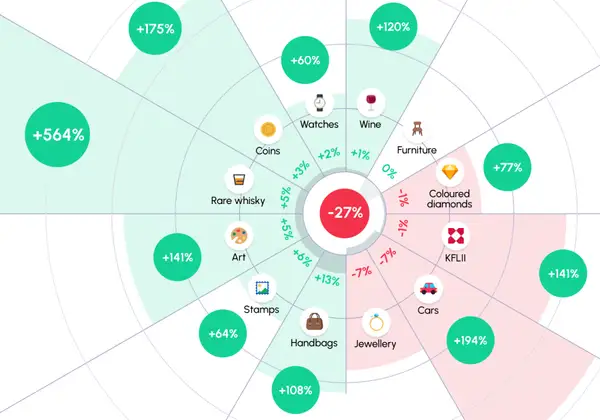
Are Watches a Good Investment?
In this exploration of investment alternatives, one area that has been catching the discerning eye of investors is the realm of luxury watches. This might beg the question, “So, are watches a good investment or not?” Take, for instance, the legendary timepieces crafted by the likes of Rolex and Patek Philippe. In the past years alone, the value of these horological marvels has soared to astonishing heights. Rolex, synonymous with timeless elegance and precision, has seen its value surge by a remarkable 93%. Patek Philippe, the epitome of Swiss watchmaking mastery, has experienced an even more remarkable ascent, with its watches appreciating by a staggering 207%. As such, it's undeniable that the best investment watches appreciate in value over time.
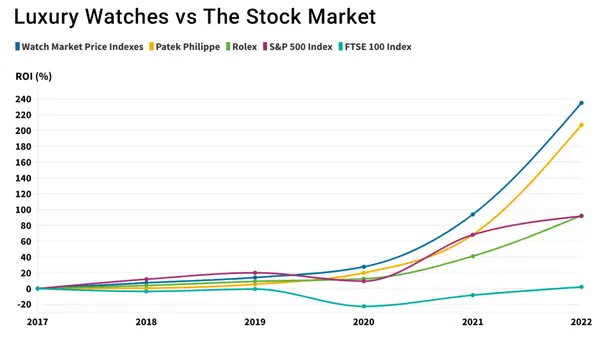
“I can tell you, never ever in the 25 years I have been in the watch industry, we have never experienced such strong growth”
A watch industry expert describes seeing crypto-level demand for “hype watches” (self-explanatory) for the first time.
To fully appreciate the potential of investing in watches, let us delve into the annals of time. Consider, for a moment, the price of a Rolex in 1970, a mere $230. Fast forward to the present day, and that same timepiece now commands a princely sum of $28,800. This represents a staggering total return on investment, with an annualized return of 16.29%. Such numbers are remarkable and undeniably make a compelling case for considering watches as a viable investment option.
However, as with any investment, the picture is not always as idyllic as it may seem at first glance. The intricacies and nuances of the watch market require a discerning eye and an understanding of the potential pitfalls that lie in wait. We aim to impart this knowledge in this article—an exploration of the ins and outs of investing in watches.
Overview of the Luxury Watch Market
In the world of luxury watches, the debate goes on regarding their viability as investments. Some advise collectors to follow their hearts and disregard value retention, while others champion certain models from esteemed brands like Rolex, Patek Philippe, and Audemars Piguet as some of the best watches to invest in. As with many things in life, watch enthusiasts say the truth lies in the middle.
For those not knowledgeable in watches and seeking long-term investments, arguably, the more reliable and secure bet would be the S&P 500. However, for investors who can create a diversified watch portfolio and focus on acquiring rare timepieces with intriguing complications and unique aesthetics, the value of their acquisitions might naturally grow due to the qualities of craftsmanship and scarcity.
The key to navigating this market successfully is to adhere to the golden rule of investing: never venture into something you do not truly comprehend. This principle holds particularly true for watches, as we shall delve further. Let us now provide a structured overview, presenting concise examples of the various points surrounding luxury watches as investments:
Rising List Prices: A compelling argument supporting watches as investments lie in the continuous escalation of list prices. Renowned brands such as Rolex, Patek Philippe, Audemars Piguet and A. Lange & Söhne routinely raise their suggested retail prices by 6% to 8% annually. For instance, if a model is purchased at its initial release, the list price may surge by up to 61% over a production cycle.
Limited Edition Rarity: Scarcity plays a pivotal role in driving up the value of limited edition watches. Kurono Tokyo, known for its limited releases in the hundreds a few times a year, exemplifies this phenomenon.
Low Production Volumes: Top watch brands maintain low production volumes, even among non-limited edition models. Patek Philippe produces 60,000 watches annually, Audemars Piguet 40,000, and A. Lange & Söhne 5,000. Independent Watchmakers: Independent watchmakers like F.P. Journe, De Bethune, and Grönefeld operate with even lower production volumes. For example, F.P. Journe only produces 900 watches annually, while De Bethune and Grönefeld produce 160 and 60 watches, respectively. The exclusivity and craftsmanship of these timepieces further enhance their investment appeal.
“Demand is driving that, of course, inflation as well—but inflation only accounts for maybe 20%,” “The vast majority is overwhelming demand. Supply has been constrained, and demand just keeps surging globally.”
Altieri
When it comes to watches, considering various factors is crucial, particularly as we will delve into the value aspect later; for many, it is not solely about financial gains but also the cultural significance and the ability to pass down a cherished piece to future generations. Luxury watches do not adhere to the traditional “cheap deal” mentality of typical investments, as they fall under the category of “Veblen goods,” where the mantra holds true: “Price Up, Demand Up.”
How to Invest in Luxury Watches?
Beyond the traditional approach of acquiring a watch to pass it down through generations, investing in luxury watches can encompass various strategies, including watch reselling and fractional investing.
Reselling Watches
In the captivating realm of watch reselling, the allure of turning a profit on coveted timepieces seems alluringly attainable. Picture this: browsing online listings on Chrono24 or Hoodinke, connecting with the right sellers, meticulously researching which models are poised to appreciate, and finally securing a client who eagerly pays a premium for your expertly sourced watch. It sounds like a dream venture, doesn’t it? However, the reality of watch reselling is often more complex and nuanced than meets the eye.

Let’s begin by acknowledging that, like many commodities, most watches, particularly non-limited editions, tend to lose value over time. Similar to the automotive industry, where prices plummet within the first 1-2 years, watches follow a similar trajectory. This depreciation is an important factor to consider when venturing into reselling.
Another obstacle is when attempting to acquire sought-after, hard-to-obtain models at retail prices. It mirrors the experiences of IPOs in the stock market, where a privileged few secure stocks at the initial offering price due to their established status as major account clients. Consequently, investing in highly sought-after sports luxury watches or other desirable pieces remains an elusive dream for the common investor.
While there are instances of watches experiencing a surge in value upon release, this upward trajectory often dissipates as production catches up with demand. Take, for example, the Tudor Black Bay GMT, unveiled alongside Rolex’s captivating “Pepsi” GMT in 2018. During its initial year, this timepiece witnessed an impressive price increase of 10-15% over the list price. However, as expected, secondary market prices eventually settled below the list price as production ramped up. Brands such as Tudor carefully regulate production quantities to align with market demand, effectively establishing the list price as the approximate value ceiling.
Opting for pre-owned watch platforms is a convenient avenue to convert watches into cash. However, it’s important to note that the prices achieved through such platforms typically range from 25-35% lower than the prevailing market value.
Investing in vintage and pre-owned watches without manufacturers’ warranties carries inherent risks. Among these risks is the possibility of acquiring faulty or counterfeit timepieces. It’s treacherous when seeking to “invest” one’s hard-earned money.
As aspiring watch resellers, one must also account for the costs of servicing watches during ownership. These expenses can be substantial and should be factored into the overall cost calculation to accurately evaluate potential profitability.
Lastly, selling watches through auctions may appear enticing; however, the high commissions imposed by auction houses can significantly diminish profits. Furthermore, favourable prices are not guaranteed in these competitive bidding environments.
As we explore the world of watch reselling, it becomes evident that behind the allure and potential profitability lies a landscape fraught with challenges. Understanding the intricate dynamics of the market, including factors such as value depreciation, the difficulty of acquiring coveted models, production catch-up, platform pricing differentials, service costs, the risks of vintage purchases, and the uncertainties of auctions, is essential for anyone seeking success.
Fractional Investing in Watches
A relatively new approach in watch investing is fractional ownership through various avenues. One option is to participate in Watch Funds or Alternative Investment Funds. In this case, you don’t have to worry about which watches will appreciate in value since a team of experts curates a portfolio of investment-grade watches on behalf of the investors. These funds acquire watches across different categories, offering fractional ownership and a share in the returns.

Watch Funds typically focus on four distinct categories of watches. The first category includes “queue-cutting” watches, where the fund leverages connections and prior knowledge to secure timepieces before they are released to the general market. The second category comprises extremely limited editions, often allocated exclusively to VIPs and individuals with exceptional access. Provenance pieces comprise the third category, encompassing timepieces previously owned or worn by renowned figures such as royalty or historical icons, which hold unique historical value. Lastly, the funds may also acquire watches in the price advantage category, obtaining certain timepieces at significant discounts compared to their retail or distributor cost.
Despite the potential benefits, there are several downsides to fractional investing in watches. One significant drawback is the loss of personal involvement and the diminished sense of being a collector. When participating in Watch Funds or Alternative Investment Funds, the selection and purchase of watches are handled by experts on behalf of the investors. Consequently, investors may not have the opportunity to exercise their preferences, which takes away a significant part of the enjoyment and satisfaction derived from personally curating a watch collection.
Another challenge is the potential time horizon for returns. Investing in watches through fractional ownership often requires a long-term commitment, with investment horizons extending beyond 10 years. This extended timeframe makes the investment illiquid, limiting the ability to quickly flip or exit the investment if desired. Investors should be prepared for a patient and long-term approach, as the value appreciation of watches may take time to materialize.
Furthermore, the accessibility of these funds is limited. Most Watch Funds primarily target accredited investors, meaning individuals who meet specific financial criteria or have a high net worth. These funds often require a minimum investment of at least $20,000 or more, making it difficult for average retail investors to participate and earn a passive income from fractional watch ownership. The exclusivity of the funds restricts the potential investor base and narrows the pool of individuals who can benefit from these investment opportunities.
While fractional investing in watches presents an intriguing avenue for gaining exposure to the luxury watch market, it is important to consider these downsides, including the loss of personal involvement, the long investment horizon, and the limited accessibility for retail investors.
Reselling vs Fractional Investing in Watches
Ultimately, choosing how to invest in watches depends on personal preferences and goals. Whether you’re a passionate collector, focused on making profits, or both, deciding what suits you best is essential. For that reason, here is a head-to-head comparison of the two different styles for investment aspects like “Personal Collector Involvement”, “Control Over Selection”, “Time Horizon”, “Liquidity”, “Potential Returns”, “Access to Exclusive Pieces”, “Investment Amount”. In the next chapter, we’ll explore a third approach combining profit-seeking aspects from both approaches, offering a potentially enticing option for investors. So, keep reading to discover this intriguing alternative.
Reselling
Personal Collector Involvement: High
Control Over Selection: Choose watches to buy/sell
Time Horizon: Shorter term
Liquidity: Potentially higher
Potential Returns: Varies based on market conditions and individual choices.
Access to Exclusive Pieces: Limited, depends on personal connections and availability
Investment Amount: Flexible, can start with a single watch
Fractional Investing
Personal Collector Involvement: Low
Control Over Selection: Relinquished to fund managers or index composition
Time Horizon: Longer term (10 years+)
Liquidity: Limited due to a longer investment horizon
Potential Returns: Tied to the overall performance of the fund or index
Access to Exclusive Pieces: Possible, depending on the fund's strategy
Investment Amount: Typically higher (e.g., a minimum investment of $20,000 for accredited investors)
Best Alternative: Invest in Watches With Morpher
Investing in watches with Morpher offers a unique and compelling approach that combines the best aspects of the previous approaches while mitigating their weaknesses. Unlike traditional methods, Morpher introduces the concept of watch markets, representing the average price of several watches. Each market tracks a specific watch model with different variants at varying prices. This approach provides more control than investing in a brand alone and reduces the risks associated with individual timepieces.
With Morpher, you can invest in entire indexes of exclusive watches, making it an appealing option. Rather than allocating your investment to one or two watches and hoping for their appreciation, you can diversify your investment across different indexes. This means that for as little as $1, you can invest in multiple indexes, each comprising around 10 watches. To purchase all these approximately 50 models individually, you would typically require a substantial amount, starting from $2.5 million and a lot of time.
One of the significant advantages of investing through Morpher is accessibility. You don’t need to be an accredited investor or possess a large capital to participate. Whether you invest $1 or $10,000 you can distribute your investment across various indexes, thereby gaining exposure to a diverse range of watches. Additionally, liquidity is maximized in this approach, as you can buy and sell your investments anytime, mirroring the flexibility of stock trading.
While this approach may not allow investment in super-duper ultra-rare models and lacks a certain collector’s touch-and-appreciate craftsmanship experience, it does provide significant investment benefits. Previously, these watches were exclusive to the super-rich, with price tags ranging from $20,000 to millions. However, now you can access an entire collection with the freedom to invest as much or as little as you desire. It is almost like creating the ideal opportunity for profit-driven watch enthusiasts. Also, it’s super fast and easy to do – let us show you:
- Register on Morpher and verify your account
- Choose the Unique Markets and select Watches
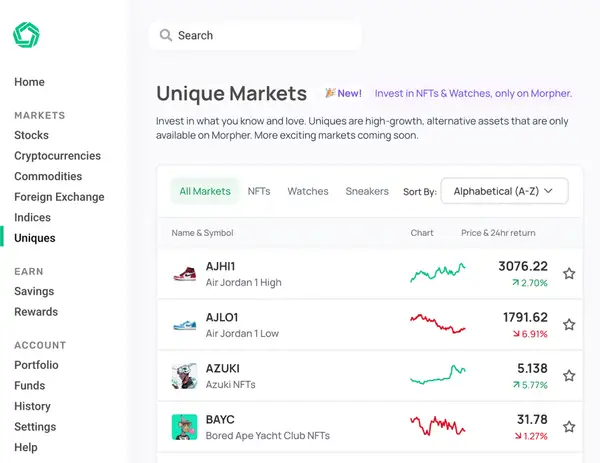
- Choose a collection and start trading
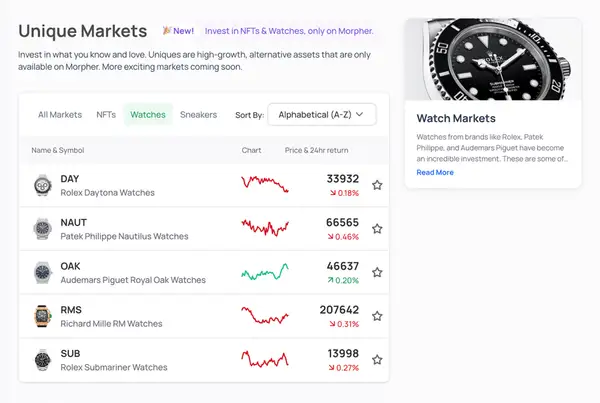
- Enjoy the convenience of trading with various indicators and tracking price movements of major collections like Rolex Submariner, Rolex Daytona, Audemars Piguet Royal Oak, Richard Mille RM and Patek Philippe Nautilus.
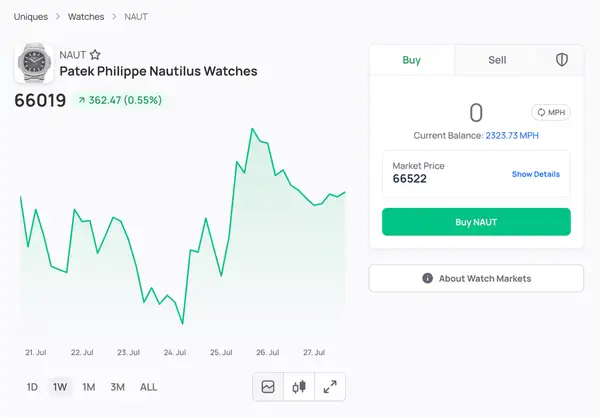
On Morpher, the possibilities extend beyond just investing in watches. You can trade diverse assets, including stocks, cryptocurrencies, forex, commodities, and even unique markets such as NFTs and sneakers. This multifaceted platform allows you to explore various investment avenues and expand your portfolio beyond traditional markets.
Morpher offers the option to apply 10x leverage and engage in short selling for those interested in traditional markets. This feature empowers traders to potentially profit from rising and falling prices, a concept that might soon be extended to the watch markets. Imagine the ability to capitalize on market trends, whether prices are surging or declining, and make the most of your investment strategy. So go ahead and become a luxury watch investor in no time.
What Influences the Value of Watches
Watches can often come with hefty price tags. If you've ever wondered why watches are so expensive, you're not alone. After all, it's not just about telling the time, it's also about the craftsmanship, materials, and brand reputation. In watch valuation, numerous factors come into play, and while we may not possess all the answers, several theories provide insightful perspectives on the matter.
Mimetic Theory
Mimetic Theory, derived from the works of renowned authors such as Marcel Proust and William Shakespeare, proposes that our cultural behaviours, including the acquisition of desires, stem from imitation. According to this theory, our desires are shaped by the desires of others, leading to a theatre of envy where we imitate the objects of our aspirations. While the theory offers an intriguing lens through which to view the value of watches, it does not provide a definitive answer.
Watches as Veblen Goods
The concept of Veblen goods highlights the innate status-seeking nature of humans. Unlike traditional economic principles, where demand decreases as price rises, Veblen goods exhibit a unique dynamic: as the price increases, so does the demand. These goods serve as signalling mechanisms, allowing individuals to showcase their elevated status or refined taste. Luxury brands have capitalized on our desire to signal, creating carefully curated, high-priced goods that symbolise exclusivity and social distinction. The Veblen effect extends beyond traditional luxury goods, encompassing many assets, including art, NFTs, stocks, and sneakers. While these goods may be referred to as “investments,” it remains to be seen how the dynamics will unfold as prices fluctuate and demand evolves.
The History and Characteristics of Luxury Goods
True luxury brands embody several distinct characteristics. They obsess over quality and craftsmanship, remaining true to their core image while constantly innovating. These brands evoke a sense of exclusivity and scarcity, making their products highly coveted and requiring intentional efforts from consumers to acquire them. Luxury goods also evoke a particular status in the minds of buyers and the general public, symbolizing wealth, refined taste, or an appreciation for culture and history.
Rolex, for instance, epitomizes the pursuit of quality, employing top-tier materials and vertically integrating their production processes. The brand’s dedication to quality control is unmatched, with meticulous testing and hand-finishing procedures. Rolex’s strategic approach, including restricting supply and periodically discontinuing models, contributes to the brand’s exclusivity and desirability. Moreover, Rolex’s heritage and association with esteemed individuals, exemplified by high-profile auctions, further enhance its status in the luxury watch market.
Ultimately, the value of watches is influenced by a complex interplay of factors, including cultural imitation, signalling dynamics, and the allure of luxury. Understanding these theories and characteristics can provide valuable insights, but the intricacies of watch valuation remain a fascinating and ever-evolving realm.
Best Watches to Invest In
Well, armed with all this knowledge about the impressive performance of luxury watches as investments, you might be wondering where to begin. Allow us to provide some guidance on your horological investment journey. Probably, everyone would agree that the holy grail over time would be the three main brands: Patek Philippe, Rolex and Audemars Piguet.
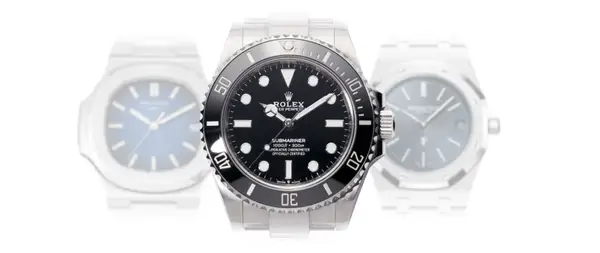
Patek Philippe’s Nautilus has seen remarkable growth, with its grey market price soaring from £41k to £96.3k, translating to a 135% return over these years. Patek Philippe’s reputation for quality and its status as an independent, family-owned manufacturer contribute to its value. The scarcity of its watches, estimated to produce under 70,000 timepieces annually, adds to their allure.
If you're looking to make a long-term investment, Rolex watches should be your go-to guide. Rolex offers several models that not only maintain, but almost always increase their value over time. Like the iconic Rolex Daytona, known for its timeless design. With a retail price of £14,500 and an average selling price of £22,000, it has provided a 52% return. The Daytona’s enduring appeal, coupled with the complexity of its production process, limits its availability and ensures its value.
The Audemars Piguet Royal Oak, renowned for its bold design, has doubled in price over the past three years. Originally priced at £18k, it now sells for an average of £36k. Its exclusivity and scarcity contribute to the elevated prices in the second-hand market.
With their classic designs and strong brand reputations, these watches have demonstrated their ability to outperform traditional investments. While some may be sceptical of considering timepieces as investments, their track record of delivering returns makes them a compelling alternative investment option.
Conclusion
In this brief exploration, we have unravelled the essence of investing in watches, shedding light on the remarkable returns they can yield. As wise investors, let us embrace the principle of diversification and expand our horizons beyond traditional avenues.
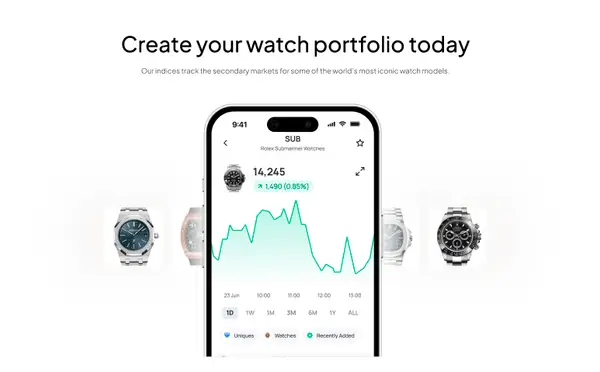
With Morpher, you can journey through time and seize the chance to invest in the finest and most exclusive timepieces that adorn the wrists of the privileged few. Whether your heart yearns for the classic brands or desires to tread the path of extravagance with Richard Mille on Morpher, you can invest in all.

Disclaimer: All investments involve risk, and the past performance of a security, industry, sector, market, financial product, trading strategy, or individual’s trading does not guarantee future results or returns. Investors are fully responsible for any investment decisions they make. Such decisions should be based solely on an evaluation of their financial circumstances, investment objectives, risk tolerance, and liquidity needs. This post does not constitute investment advice.

Painless trading for everyone
Hundreds of markets all in one place - Apple, Bitcoin, Gold, Watches, NFTs, Sneakers and so much more.

Painless trading for everyone
Hundreds of markets all in one place - Apple, Bitcoin, Gold, Watches, NFTs, Sneakers and so much more.

